
Philip Miller FRS was an English botanist and gardener of Scottish descent. Miller was chief gardener at the Chelsea Physic Garden for nearly 50 years from 1722, and wrote the highly popular The Gardeners Dictionary.

Hepatica is a genus of herbaceous perennials in the buttercup family, native to central and northern Europe, Asia and eastern North America. Some botanists include Hepatica within a wider interpretation of Anemone.
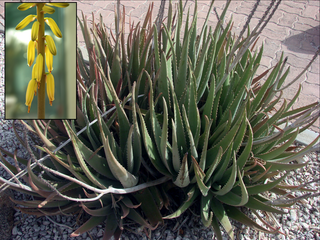
Aloe vera is a succulent plant species of the genus Aloe. Having some 500 species, Aloe is widely distributed, and is considered an invasive species in many world regions.

Damasonium alisma is a species of flowering marsh plant known by the common name of starfruit. Its native range includes parts of Great Britain, France, Portugal, Spain, Italy, Greece, Russia, Ukraine, Moldova, and Kazakhstan.

Acacia, commonly known as the wattles or acacias, is a large genus of shrubs and trees in the subfamily Mimosoideae of the pea family Fabaceae. Initially, it comprised a group of plant species native to Angola and Australasia. The genus name is New Latin, borrowed from the Greek ἀκακία, a term used by Dioscorides for a preparation extracted from the leaves and fruit pods of Vachellia nilotica, the original type of the genus. In his Pinax (1623), Gaspard Bauhin mentioned the Greek ἀκακία from Dioscorides as the origin of the Latin name.

The Global Biodiversity Information Facility (GBIF) is an international organisation that focuses on making scientific data on biodiversity available via the Internet using web services. The data are provided by many institutions from around the world; GBIF's information architecture makes these data accessible and searchable through a single portal. Data available through the GBIF portal are primarily distribution data on plants, animals, fungi, and microbes for the world, and scientific names data.
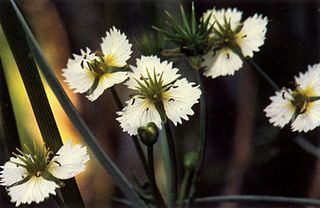
Damasonium is a genus of six species of flowering plants in the family Alismataceae, commonly known as starfruit and by the older name thrumwort. The genus has a subcosmopolitan but very patchy distribution.

The Field Elm cultivar Ulmus minor 'Plotii', commonly known as Lock Elm or Lock's Elm, Plot's Elm or Plot Elm, and first classified as Ulmus sativaMill. var. Lockii and later as Ulmus plotii by Druce in 1907-11, is endemic mainly to the East Midlands of England, notably around the River Witham in Lincolnshire, in the Trent Valley around Newark-on-Trent, and around the village of Laxton, Northamptonshire. Ronald Melville suggested that the tree's distribution may be related to river valley systems, in particular those of the Trent, Witham, Welland, and Nene. Two further populations existed in Gloucestershire. It has been described as Britain's rarest native elm, and recorded by The Wildlife Trust as a nationally scarce species.
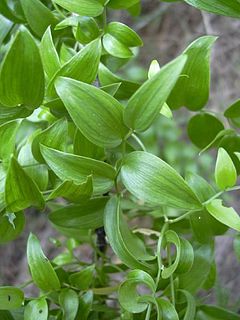
Asparagus asparagoides, commonly known as bridal creeper, bridal-veil creeper, gnarboola, smilax or smilax asparagus, is a herbaceous climbing plant of the family Asparagaceae native to eastern and southern Africa. Sometimes grown as an ornamental plant, it has become a serious environmental weed in Australia and New Zealand.
Gustav Lindau, was a German mycologist and botanist.

Asteriscus is a genus of flowering plants in the family Asteraceae.
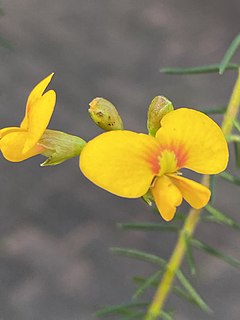
Dillwynia retorta, commonly known as eggs and bacon, is a species of flowering plant shrub in the family Fabaceae and grows in New South Wales and Queensland. It is usually an erect shrub with thin, smooth, crowded leaves and yellow flowers with red markings.
George Claridge Druce, MA, LLD, JP, FRS, FLS was an English botanist and a Mayor of Oxford.

Cleome ornithopodioides or bird spiderflower is the type species of the genus Cleome which is part of the family Cleomaceae or Brassicaceae. The species epithet means "birds-foot like".

Ehretia is a genus of flowering plants in the borage family, Boraginaceae. It contains about 50 species. The generic name honors German botanical illustrator Georg Dionysius Ehret (1708–1770).
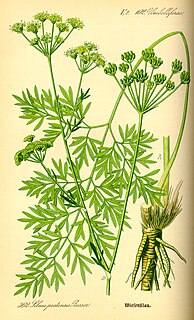
Silaum is a genus of flowering plants in the carrot/parsley family, Apiaceae. There are currently ten species placed into the genus, a list of which is provided below.

Lagenophora stipitata, commonly known as blue bottle-daisy or common lagenophora, is a small plant in the family Asteraceae, found in eastern mainland Australia and Tasmania, and also from South East China to East Asia, Java, and New Guinea.

Fielding-Druce Herbarium, part of the Department of Plant Sciences, University of Oxford, located on South Parks Road, in Oxford, England. A herbarium is a collection of herbarium sheets, with a dried pressed specimen of the botanic species, whether they were bound into a book by one dedicated individual, or have been amassed into huge collections. They are like plant ID cards. As paper was expensive, multiple specimens are normally mounted on one sheet. The 2 cores of the Herbarium collection, are bequeathed to the University from Henry Fielding (1805-1851) containing a non-British and Irish collection. It also covers most taxonomic groups and geographical areas. It is particularly rich in nineteenth century material from the Americas and south and south east Asia. The other core a British and Irish collection from George Claridge Druce (1850-1932) in 1932, this is particularly rich in specimens from Oxfordshire, Buckinghamshire and Berkshire. Other collections were added later.

World Flora Online is an Internet-based compendium of the world's plant species.

Ornithopus sativus, the serradella or common birdsfoot, is a species of flowering plant in the family Fabaceae. It is native to Southwestern Europe and Northwest Africa in Portugal, western Spain, northern Morocco and Algeria, and southwestern France and has been introduced as a legume forage to many locations around the world, including most of central and eastern Europe, Turkey, the Caucasus, the Azores, South Africa, Kenya, Java, most of Australia, the North Island of New Zealand, southern Chile, and California. It is known for producing a high‑quality forage in highly acidic, nutrient‑poor soils.



















